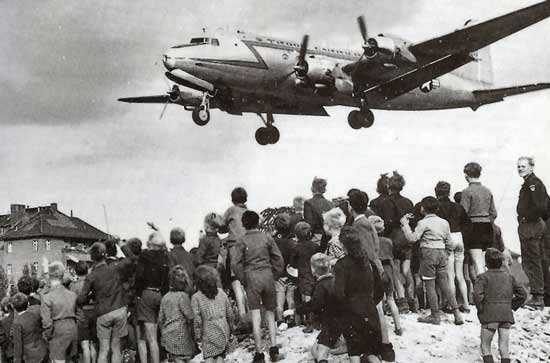Authors:
Historic Era:
Historic Theme:
Subject:
October 1969 | Volume 20, Issue 6


Authors:
Historic Era:
Historic Theme:
Subject:
October 1969 | Volume 20, Issue 6
The division of Germany after World War II into four occupation zones, with Berlin buried deep within the Russian sector, was not a happy one. The Soviets harassed the supply routes to Berlin at every opportunity, and it became painfully obvious that they intended to do everything they could to bring the capital under their full control. By the spring of 1948 the situation had reached the showdown point: on March 20 the Russians stalked out of a meeting of the Allied Control Authority and subsequently demanded the immediate removal of the troops of Britain, France, and the United States from the city. On June 25 it was announced that “the Soviet administration is compelled to halt all passenger and freight traffic to and from Berlin tomorrow at 0600 because of technical difficulties.”

West Berliners watch as a Douglas C-54 Skymaster delivers supplies to Tempelhof Airport. (1948)
There was only one way in or out of the city now, and that was by air. After the war the four powers had agreed to set up six air corridors into Berlin. Three of them went eastward. The other three connected Berlin with Hamburg and Hanover in the British Zone and with Frankfurt in the American Zone. Could the American garrison in Berlin be kept supplied by air? General Lucius D. Clay, the United States military governor, sent for General Curtis LeMay, commander of the air forces in Europe, to find out.
What happened next is told in the words of William H. Tunner, then an Air Force major general and veteran air transport commander, whose men and planes had helped keep nineteen Chinese divisions and the U.S. Fourteenth Air Force fighting in China by flying supplies from India “over the Hump” of the Himalayas during the war. He was interviewed recently at his home in Virginia.
Within a few hours General LeMay ordered a number of C-47 cargo planes, the Old Faithfuls of World War II, to Wiesbaden Air Base, near Frankfurt. They were loaded with medical supplies, milk, and flour and sent to Tempelhof Airport in Berlin. On the first day eighty tons were delivered. No one knew what the minimum daily tonnage for the American garrison would be, and no one dreamed at first that the U.S. Air Force would be expected to keep the whole city of two and a half million people alive.
The daily tonnage increased; within the first ten days over one thousand tons of cargo had been carried to Berlin, including the first shipment of coal, loaded in G.I. duffel bags. By then it was understood that the Americans were to supply the needs of all Berliners and not just the American troops there.
About this time General Albert C. Wedemeyer, Director of Plans and Operations of the Army General Staff, had been sent to Germany to observe what was happening. He had commanded the China theatre and knew what it was like to be cut off